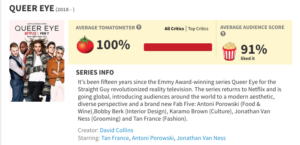If you’ve been on Netflix during February, you’ve probably noticed the revival of the early noughties classic Queer Eye for the Straight Guy – Netflix’s own Queer Eye has been getting a ton of praise from critics and audiences alike and seems well on track to be a lasting hit.
The show is notable for taking the Queer-positive message of the original series and updating it for the modern era: whereas the initial Queer Eye aimed to bring LGBTQI issues into the spotlight in a manner never seen before on TV, the modern incarnation is focused on normalising this presence and reinforcing positive attitudes in both the episode’s subjects and viewers.
Of course, this campaign has also long been a feature of webcomics: some of the greatest comic art on the web has either been created by LGBTQI artists/writers, and the themes of acceptance and tolerance, and deep explorations of sexuality and gender are common on the digital page. Below are only a few examples amongst dozens of webcomics which have elegantly and eloquently presented these issues to their audiences. Continue reading
